Chevrolet Impala
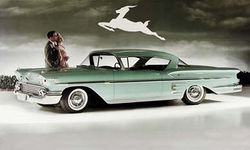 |
|
| Manufacturer | Chevrolet |
|---|---|
| Production | |
| Model year(s) |
|
| Class | Full-size |
The Chevrolet Impala is a full-size automobile built by the Chevrolet division of General Motors introduced for the 1958 model year. Deriving its name from the southern African antelope, Chevrolet's most expensive passenger model through 1965 had become the best selling automobile in the United States, competing against the Ford Galaxie 500 and the Plymouth Fury when full-size models dominated the market. The Impala was distinguished for many years by its symmetrical triple taillights. The Caprice was introduced as a top-line Impala Sport Sedan for the 1965 model year becoming a separate series positioned above the Impala in 1966, which itself remained above the Bel Air and Biscayne. The Impala continued as Chevrolet's most popular full-size model through the mid-eighties. Reintroduced for the 1994 model year, the Impala SS was produced through 1996 based on the Caprice Classic sedan. The SS featured a 5.7-liter (350 cu in) small-block V8. The current Impala model range produced since 2000 is built on a front wheel drive (FWD) mid-size platform.[3]
History
Origin
The Impala name was first used for the full-sized 1956 General Motors Motorama show car that bore Corvette-esque design cues, especially the grille. Painted emerald green metallic, with a white interior, the Impala featured hardtop styling. It is not known to have survived.Ed Cole, Chevrolet's chief engineer in the late 1950s, defined the Impala as a "prestige car within the reach of the average American citizen." Clare MacKichan's design team, along with designers from Pontiac, started to establish basic packaging and dimensions for their shared 1958 General Motors A body in June; the first styling sketch that would directly influence the finished Chevrolet product caught the eye of General Motors Styling vice president Harley Earl in October. Seven months later, the basic design was worked out.
Sales overview
From 1958 through 1996, Impala sales were in excess of 13 million, more than any other full-size car in the history of the automobile. The 1964 model year sales of 1,074,925 units (Impala & Impala SS) in the U.S. still stands as a record. 1965 wasn't far behind with 1,046,500 units. In 2008, Impala was the 6th best selling car in the United States and had the distinction of being the top selling American nameplate sedan, according to Reuters Top 20 Best-selling Vehicles Scorecard.[4]
First generation (1958)
 |
|
| Production | 1957–1958[5] |
|---|---|
| Model year(s) | 1958 |
| Body style(s) |
|
| Layout | FR layout |
| Engine(s) | 235 cu in (3.9 L) Blue Flame I6 283 cu in (4.6 L) Turbo Fire V8 348 cu in (5.7 L) W-series Turbo Thrust V8 |
| Related | Chevrolet Bel Air, Chevrolet Biscayne, Chevrolet Brookwood, Chevrolet Nomad, Chevrolet Parkwood |

The Impala was introduced in 1958 and positioned as top of the line Bel Air coupes and convertibles. From the windshield pillar rearward, the 1958 Chevrolet Bel Air Impala differed structurally from typical Chevrolets. Hardtops had a slightly shorter greenhouse and longer rear deck, giving the impression of an extended body.
It was a change from the 1955–1957 shape that was itself a substantial move away from the conservative Chevrolets of past years, longer, lower, and wider than its predecessors.[6] The sharp tailfins of the 1957 gave way to deeply sculptured rear fenders. Three taillights each side would become an Impala hallmark whereas lesser models had two and wagons just one. Special crossed-flag insignias sat above the side moldings plus bright rocker moldings and dummy rear-fender scoops. 1958 was the first year of dual headlamps.
Underneath this new body was a new chassis. The standard perimeter-type frame was abandoned, replaced by a unit with rails laid out in the form of an elongated "X." Chevrolet claimed that the new frame offered increased torsional rigidity and allowed for a lower, yet still roomy passenger compartment. In this design, a transitional step between traditional construction and the later fully unitized body/chassis, the body structure was beefed up in a number of areas (most notably the rocker panels and firewall) to create a solid package.[7]
With a six-cylinder engine, a Chevrolet Bel Air Impala started at $2,586, while $2,693 bought a V-8. In all, 55,989 ragtops and 125,480 Sport Coupes were built, 15 percent of production. Interiors held a two-spoke steering wheel and color-keyed door panels with brushed aluminum trim. No other series included a convertible. Impala signaled Chevrolet's entry into the mid-price field, even if the design was less radical than planned. In addition to style and vigorous performance, ads marketed its "quick, eager-to-please handling that lets you know you're the boss." Longer, lower, and wider—a recurrent theme-all Chevrolets had full-coil suspension, displacing the old rear leaf springs. A new "Safety Girder" X-type frame reduced height without headroom loss. A 283-cubic-inch engine was now the standard V-8, with ratings that ranged from 185 to 290 horsepower. A big-block 348-cubic-inch Turbo-Thrust V-8 was a new engine option, descended from a truck engine putting out 250, 280, or 315 horsepower. The 1958 Chevrolet Bel Air Impala helped Chevrolet regain the number one production spotin this recession year.[3]
Second generation (1959–1960)
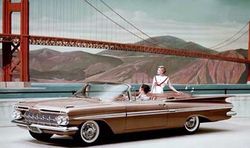 1959 Chevrolet Impala Convertible Coupe 1959 Chevrolet Impala Convertible Coupe |
|
| Production | 1958–1960[5] |
|---|---|
| Model year(s) | 1959–1960 |
| Body style(s) |
|
| Layout | FR layout |
| Engine(s) | |
| Related | Chevrolet Bel Air, Chevrolet Biscayne, Chevrolet Nomad, Chevrolet Brookwood, Chevrolet Parkwood, Chevrolet El Camino |
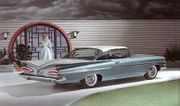
The 1959 Chevrolet Impala was radically reworked sharing bodyshells with lower-end Buicks and Oldsmobiles as well as with Pontiac, part of a GM economy move, Chevrolets rode a wheelbase 11/2 inches longer than before. Atop a new X-frame chassis, roofs sat three inches lower, and bodies measured more than two inches wider overall. The growing size contributed to increased curb weight, one more trend of the times. Its tailfins protruded outward rather than upward. Auto tester Tom McCahill, of Mechanix Illustrated, declared that a Chevy's decklid had "enough room to land a Piper Cub."
Impala was now a separate series, including a four-door hardtop and four-door sedan, as well as the two-door Sport Coupe and convertible. Sport Coupes featured a shortened roofline and wrap-over back window, promising a "virtually unlimited rear view" to complement the car's new compound-curve windshield. The hardtop Sport Sedan had a huge, pillar-free back window and "flying wing" roofline. Base V-8 was the carryover 283, at 185 horsepower. Performance fans could select 283-cubic-inch outputs to 290 horsepower – or turn to the big-block 348-cubic-inch V-8 up to 315 horsepower. With a V-8, the Impala convertible listed at $2,967, but a six-cylinder version saved the customer $118. Impala interiors flaunted their top-of-the-line status, offering front and rear armrests, an electric clock, dual sliding sun visors, and crank-operated front ventipanes. A contoured instrument panel held deep-set gauges residing below hoods to prevent glare. A Flexomatic six-way power seat was a new option.
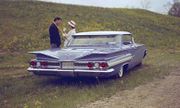
The 1960 models created a more conservative look than was seen on the 1959 models and were simply toned down a bit. Stylists and marketers realized that the fin-and-chrome fashion had about run its course decided to shift direction, creating a more conservative face-lift. The effect was helped by installation of three modestly sized round taillights on each side of the top-of-the-line Impala. Up front the nostril air intakes above the headlights were deleted completely. More abundantly chromed than Bel Airs or Biscaynes, Impalas found buyers more easily, with better than 490,000 built. Impalas displayed nonfunctional air-intake scoops, plus a white band running along the rear fender. Four body styles vied for customers: Hardtop Sport Sedan, Sport Coupe, Convertible Coupe, and Four-Door Sedan. The Impala Convertible Coupe at $2,847 led the line.
Drivetrain choices were slightly reduced to seven V8s in 283- or 348-cubic-inch size. Top choice was the 348-cubic-inch Super Turbo-Thrust Special, breathing through triple two-barrel carburetors and using 11.25:1 compression and dual exhausts to put out 335 horsepower. More modest versions of the 348 yielded 250 to 320 horses. The carbureted Turbo-Fire 283-cubic-inch V-8 could have either 170 or 230 horsepower. Fuel injection was no longer an option on full size Chevrolets.[6]
Third generation (1961–1964)
 1961 Chevrolet Impala Convertible Coupe 1961 Chevrolet Impala Convertible Coupe |
|
| Production | 1960–1964[5] |
|---|---|
| Model year(s) | 1961–1964 |
| Assembly | Arlington, Texas |
| Body style(s) |
|
| Layout | FR layout |
| Platform | B-body |
| Engine(s) |
|
| Related |
|

The Impala was restyled on the existing GM B platform for 1961. The new body styling was more trim and boxy than the 1958–60 models. Sport Coupe models featured a "bubbleback" roof line style for '61, and a unique model, the 2-door pillared sedan, was available for 1961 only. It was rarely ordered and a scarce collectible today. The rare Super Sport (SS) option debuted for 1961. This was also the last year the top station wagon model would bear the Nomad name.
The 1962 model featured new "C" pillar styling for all models except the 4-door hardtop "Sport Sedan." Sport Coupe models now featured the "convertible roof" styling, shared with other GM "B" full-size hardtop coupes. This style proved extremely popular, and contributed to the desirability of the '62–'64 Impalas as collectibles. The "overhang" roof style of the sedans was replaced with a more attractive, wider "C" pillar with wraparound rear window. Engine choices for '62 settled down, the 348-cubic-inch (5.7 L) V8 discontinued and replaced by the 340 brake horsepower (250 kW) 409-cubic-inch (6.7 L), which could be ordered with any transmission. The small-block 283 was enlarged to 327 cubic inches (5.4 L), which added more engine choices for small-block fans. The Beach Boys produced a hit single, "409," referring to the Chevy, which became an iconic song for these cars. Impalas again featured premium interior appointments, plusher seats, and more chrome trim outside, including a full-width aluminum-and-chrome panel to house the triple-unit taillight assembly. Super Sport (SS) models featured that panel in a special engine-turned aluminum, which was also used to fill the side moldings, making the SS more distinctive in appearance. Impala also gains the top station wagon after the Chevrolet Nomad|Nomad]] is gone. Due to reliability problems, the optional Turboglide automatic transmission was discontinued, leaving Powerglide the only automatic transmission available until 1965.
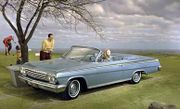
Among collectors, the 1963 Impala is the most popular for its body style, though it was almost mechanically identical to the 1962 model. The 1963 Impala's distinctive body style has crisp lines with pointed front and rear fenders which emphasize the long, low style of car design popular in the early 1960s. The rear taillight panel was aluminum, and was surrounded by a chrome border with the engine-turned surface on SS models. Engine choice was similar to '62, with the small-block 283-cubic-inch (4.6 L) and 327-cubic-inch (5.4 L) V8s the most popular choices. The Sport Sedan featured a new, creased roof line that proved popular. A new "coved" instrument panel was good-looking, but replaced the temperature gauge with "idiot lights" for hot and cold engine conditions. An optional factory tachometer was built into the dash, just above the steering wheel. It was rarely ordered, but gave the Super Sport models an extra feel of sportiness.
For 1964, the Impala was slightly restyled, reverting to a more rounded, softer look. The signature taillight assembly had an "upside-down U" shaped aluminum trim strip above the taillights, but the lights themselves were surrounded by a body-colored panel. The 409-cubic-inch (6.7 L) returned as the big-block option, as well as the 4X2 carburetor setup for the 400 and 425 horsepower motors. SS models continued to feature the engine-turned aluminum trim. Rooflines were carried over from '63 unchanged. The 1964 model has been praised by West Coast rap groups since the early 1990s, with endorsers such as Eazy-E, Dr. Dre, Skee-Lo and The Game among many others.
Right hand drive cars were made at GM's Oshawa plant in Canada and often shipped overseas in kit form for assembly in South Africa, Australia and New Zealand. The RHD cars – Chevy or equivalent Pontiac (built on Chevrolet frames and using Chevy engines in Canada – all used a RHD version of the LHD 1961 Pontiac dashboard.
Fourth generation (1965–1970)
 1966 Impala SS Convertible 1966 Impala SS Convertible |
|
| Production | 1964–1970[8] |
|---|---|
| Model year(s) | 1965–1970 |
| Assembly | Arlington Texas, Atlanta Georgia, South Gate California, Flint Michigan, Framingham Massachusetts, Janesville Wisconsin, Van Nuys California, Norwood Ohio, St. Louis Missouri, Tarrytown New York, Lordstown Ohio, Wilmington Delaware, Oshawa Ontario, Sainte-Thérèse Quebec |
| Body style(s) |
|
| Layout | FR layout |
| Platform | B-body |
| Engine(s) |
|
| Related | Chevrolet Caprice, Chevrolet Bel Air, Chevrolet Biscayne |
Totally redesigned in 1965, the Impala set an all-time industry annual sales record of more than 1 million units in the U.S., which has never been bettered. All new full-size Chevys eschewed the "X" frame for a full-width perimeter frame, a new body which featured curved, frameless side glass (for pillarless models), sharper angled windshield with newly-reshaped vent windows, and redesigned full-coil suspension.

In 1965 Chevrolet introduced the Impala Caprice, exclusively as a four-door hardtop sedan. Impala Caprices received unique upholstery, wood grained accents on the dashboard and specialty pulls on the insides of the doors. The Caprice Custom was reintroduced as the Chevrolet Caprice in 1966, taking the top position in the full-size Chevrolet lineup. Engine choices included the inline six-cylinder as well as the famous Chevy small-block and big-block V8s. Automatic buyers were given the option of the newly-introduced three-range Turbo Hydra-Matic transmission for the newly-introduced Mark IV big-block engine, displacing 396 cubic inches. The old 409-cubic-inch (6.7 L) "W" engine was discontinued early in the 1965 model year, so early-production '65s got the 409, as well as 1/10th of 1% had the 396 CID big-block. Moreover, other later-built cars had the 396-cubic-inch (6.5 L) as the big-block option with significant horsepower drawback. Two-range Powerglide, as well as Synchro-Mesh 3- and 4-speed manual transmissions were available.
As with previous years, Impalas featured more chrome trim inside and out, with pleated tufted upholstery and door panels.The Impala would be the #2-selling convertible in the U.S. in 1966, with 38,000 sold; it was beaten by the Mustang by almost 2:1.[9] The 1967 model was redesigned with enhanced Coke bottle styling. The curves were the most pronounced with the 1967–68 models. In keeping with federal regulations, safety features were built into Impalas during the 1967 and 1968 model years, including a fully collapsible energy-absorbing steering column, side marker lights, and shoulder belts for closed models. During the 1969 model year Impala production topped Caprice production by 611,000 units. The car is used in the Supernatural (TV series) (source?). The 1968 model standard front ends had a new face, while rear bumpers held triple "horseshoe" shaped taillights.
The 1969 Impala and other full-sized Chevrolets were restyled with crisper bodylines and front bumpers that wrapped around the grille (again with optional concealed headlights, for which headlight washers could be added as a new "one year only" option) along with ventless front windows on all models. The 1970 Impala got a minor facelift featuring a more conventional under the grille bumper replacing the wrap-around unit used in 1969 along with new triple vertical taillights in the rear bumper.
Right Hand Drive cars were manufactured in Canada for export to some countries such as Australia, UK, etc., until 1969. They used a version of the 1965 Impala dash panel until 1969. Australian models were assembled in Australia from kits as this lessened tax on the cars. A similar arrangement applied in New Zealand although the bodies were supplied from Canada already welded, painted and trimmed.
Impala SS (1961–1969)
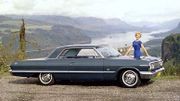

In 1961, the Impala SS (Super Sport) was introduced to the market. The SS badge was to become Chevrolet's signature of performance on many models, though it sometimes has been an appearance package only. The Impala's SS package in 1961 was truly a performance package, beginning with the 348-cubic-inch (5.7 L) V8 engines available with 305 brake horsepower (227 kW), 340 brake horsepower (250 kW), and 350 brake horsepower (260 kW) or the new 409-cubic-inch (6.7 L) V8, which was available with up to 425 brake horsepower (317 kW). The package also included upgraded tires on station wagon wheels, springs, shocks and special sintered metallic brake linings.
Starting in 1962, the Impala SS could be had with any engine available in the Impala, down to the 235-cubic-inch (3.9 L), 135 brake horsepower (101 kW) inline-6. With one exception, from this point until 1969, the SS was an appearance package only, though the heavy-duty parts and big engines could still be ordered. From 1962-on, Super Sports were limited to the hardtop coupe and convertible coupe exclusively. The Super Sport package was known by Regular Production Option (RPO) Z03, from 1962–63, and again in 1968. 1962–64 Super Sports came with engine-turned aluminum trim, which was replaced by a "blackout" trim strip in '65 which ran under the taillights.
1965 Super Sports differed slightly from regular Impalas, retaining bright windshield moldings but not the rocker panel or lower fender trim. "Super Sport" script replaced the "Impala SS" badges in 1965 and 1966. A total of 243,114 Impala SS coupes and convertibles were built for 1965. Their new center console housed a rally-type electric clock, and full instrumentation now included a vacuum gauge. The exception was the Z24 option package available in combination with the standard Z03 Super Sport package.
The 1966 Impala SS received the same facelift as other full-sized Chevys including a revised grille and new triple rectangular tailights that replaced the triple round units common to big Chevrolets since 1958 (with the exception of 1959) along with a chrome beltline strip shared with regular Impalas in response to complaints about door dings on the clean-lined 1965s. Inside were new Strato bucket seats with thinner and higher seatbacks and center console, upon which an optional gauge package was available. Sales of the 1966 Impala SS dropped by more than 50 percent to around 117,000 units, due in part to the introduction of the more luxurious Caprice coupe with a distinctive formal roofline which could also be ordered with a bucket seat/console interior that was plusher than the SS's. Also cutting into Impala SS sales was the sporty/performance car market switching from full-sized models to intermediates Chevy's own Chevelle SS-396 and Pontiac GTO, along with the emerging market for the even smaller ponycar market created by the Ford Mustang in 1964 that Chevrolet would respond to with the Camaro for 1967.

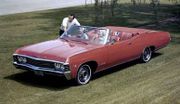
The 1967 Impala SS was less decorated than other Impalas, Super Sports had black grille accents and black-accented bodyside and rear fender moldings. Lesser models leaned more toward brightwork inside and out. Both SS models—Sport Coupe and convertible—lacked bright wheel well trim.Buyers could choose either vinyl bucket seats with a center console, or a Strato-back bench with a fold-down center armrest. Of the 76,055 Impala SS models built, just 2,124 were SS 427 editions. Only about 400 Super Sports had a six-cylinder engine. The SS427 included a heavy-duty suspension and other performance goodies, as well as a Turbo-Jet 427-cubic-inch (7.0 L) V8 in either L36 (385 brake horsepower (287 kW) in 1967–1968, 390 brake horsepower (290 kW) in 1969) or L72 (425 brake horsepower (317 kW)) in 1968–1969. Special SS427 badging, inside and out, was the rule, but few were sold since muscle car enthusiasts were looking toward big-block intermediates such as the Chevelle SS396 and Plymouth Road Runner.
In 1968 as Caprice sales escalated, those of the Impala Super Sport suffered a decline. No longer a separate series, the Super Sport was a mere $179 option package for the two Impala coupes and the convertible. Only 38,210 Impalas were so-equipped, including 1,778 with the 427-cubic-inch V-8 engine (dubbed SS 427). In 1968 only, SS427s could be ordered without the Z03 SS package, which meant SS427 equipment but no bucket seats or center console. The Impala SS could be identified by "SS" emblems on the rear fenders and trunk lid.
In 1969, the Impala SS was available only as the Z24 (SS427), coming exclusively with a 427-cubic-inch (7.0 L) V8 of 335 brake horsepower (250 kW), 390 brake horsepower (290 kW), or 425 brake horsepower (317 kW). This was the final year for the Impala SS until 1994. The 1969 Impala SS was often considered a "sleeper" in that there was no distinctive SS badging inside the car (again, there was no Z03 offered that year), and a true 1969 Z24-optioned car is the rarest and most collectible of any year with this package available. 1969 was the last year that the Impala SS was offered with the Z24 package, but the only year in which front disc brakes and 15-inch (380 mm) wheels were standard; that made the 1969 SS427 mechanically better than the previous versions in standard form. Although sales of 1969 Z24-optioned Impalas interestingly increased to approximately 2,455 units from the 1,778 Z03-optioned units of 1968, and high-powered big-block V8 engines continued to be available, there would be no Impala SS for 1970. The 427 was also replaced on the engine offerings list by a new Turbo-Jet 454 producing 390 hp for 1970.
Fifth generation (1971–1976)
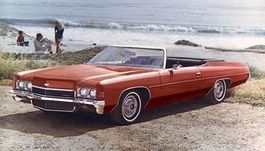 1972 Chevrolet Impala Convertible Coupe 1972 Chevrolet Impala Convertible Coupe |
|
| Production | 1970–1976[10] |
|---|---|
| Model year(s) | 1971–1976 |
| Assembly | |
| Body style(s) |
|
| Layout | FR layout |
| Platform | B-body |
| Engine(s) |
|
| Related |
|
The Impala remained Chevrolet's top-selling model with the fifth generation. A high-performance big block V8 was still available in the form of the Turbo-Jet 454, which produced 365 hp in 1971, but power decreased as the years went along. The 1971 redesigned B-body would be the largest car ever offered by Chevrolet.
The 1972 model introduced a grille which extended below the bumper. Powertrains consisted of mostly V8 engines. The 250 inline six was standard; the 350 2bbl V8 became the standard engine from 1973–1976, with 350 cubic inches (5.7 L), 400 cubic inches (6.6 L), 402 cubic inches (6.6 L) (through 72) or 454 cubic inches (7.4 L). However, the long-familiar OHV six-cylinder Turbo Thrift engine continued to be standard on two-door hardtop coupe and four-door pillared sedan models through the end of the 1972 model year. Beginning in 1972, all engines were designed to run on unleaded gasoline. 1972 saw the last Impala convertible; it sold 6,456 copies, placing fourth with just under 9% of the market, right behind the Corvette 6,508, ahead of the Mustang's 6,401.[11]

1973 Chevrolets featured a larger, shock-absorbing front bumper due to new federal mandates which required 5-mile-per-hour (8.0 km/h) impact protection. New taillights were mounted in the (still) conventional rear bumper. This was the first year of the Caprice Classic convertible.
In 1974, the rear bumper was redesigned with shock absorbers to meet the upgraded standards and new tail lights were featured. The front end was also freshened as in previous years, with a new grille and headlight bezels, a new header panel, and a bumper with a drop down center section. The marker lights moved back up beside the headlamps once again. This was the only year of the 1971–1976 models the Impala had a different front end design than the Caprice Classic, as other years used either a grille insert or previous year Caprice front to distinguish the two. The rooflines of the Impala coupes were also revised. For 1974 the Custom Coupe was no longer a hardtop, with large fixed rear quarter glass and a thick B-pillar. The Sport Coupe, still a pillar-less hardtop, now used larger roll-down quarter glass like that of the 1971–73 Custom Coupe, and had a narrower, fastback style, flat back window. Sedans used carryover body shells from previous years.
The 1975 Impala used a 1974 carried-over Caprice front end, with a grille insert and emblem change. The Caprice model was revised with a new front end with a swept back style header panel with recessed headlight buckets, a new hood, and new fenders. Also in 1975 upholstery, door panels and the dashboard were revised as were the radio and climate control graphics. Speedometers read up to 100 miles per hour (160 km/h), and added kilometers per hour. 1975 officially debuted a High Energy or HEI Ignition system, however it was installed on some 1974 cars as a clandestine option. Catalytic converters were also introduced as were several new options, including an Econominder gauge package, intermittent wipers, and a divided 50–50 bench seat (with a choice of sport cloth or vinyl trim). This was the final year of the full-size Chevrolet convertible.
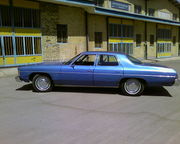

Although the "Super Sport" model was long since discontinued, a limited-edition Spirit of America package was offered in 1974 on Sport Coupe models; primarily an appearance package, it featured white or blue body paint, a white full vinyl top, white upholstery with red or blue trim, color-keyed seat belts and floormats, special wheel covers, optional white rally wheels, sports-styled dual remote outside rear view mirrors, a vinyl body side molding insert, and red pin-striping. Special fender and dashboard badges announced the package to passers-by and passengers. A Landau model was new for 1975–'76 models. Like the "Spirit of America", it was an appearance package. It featured a landau vinyl roof (with a chrome band across the roof),a choice of special paint colors, sports-styled dual remote outside rearview mirrors, color-keyed wheel covers, a vinyl bodyside molding insert, and pin-striping. Inside were color-keyed seat belts and floormats. Fender and dashboard emblems rounded out the package.
Two coupe models were offered on Impalas since 1968; the "Sport Coupe" was the lower-priced hardtop coupe design, shared with other GM "B" body hardtop coupes, and the formal-roof "Custom Coupe" which it shared with the Caprice. Sport Coupe models were discontinued after 1975, leaving redesigned Custom Coupe, with its wide "B" pillar and fixed rear window, the only 2-door Impala available in 1976. This body style had been introduced for the 1974 model year, a precursor to Detroit's complete abandonment of pillarless body styles before the end of the Seventies.
1976 Impalas used a previous year Caprice nose, with a new "egg crate" grille insert. The Impala had round headlamps while the Caprice used the new quad rectangular ones.
Engines (1958–1976)
Inline-Six:
- 235 cu in (3.9 L) Blue Flame, 1958–1962
- 230 cu in (3.8 L) 140 bhp (104 kW; 142 PS) Turbo Thrift, 1963–1965
- 250 cu in (4.1 L) 155 bhp (116 kW; 157 PS) Turbo Thrift, 1966–1969
Small-block V8:
- 283 cu in (4.6 L) 195 bhp (145 kW; 198 PS) to 220 bhp (164 kW; 223 PS) Turbo Fire, 1957–1967
- 307 cu in (5 L) 200 bhp (149 kW; 203 PS) Turbo Fire, 1968
- 327 cu in (5.4 L) 235 bhp (175 kW; 238 PS) to 375 bhp (280 kW; 380 PS) Turbo Fire, 1961–1969
- 350 cu in (5.7 L) 250 bhp (186 kW; 253 PS) to 350 bhp (261 kW; 355 PS) Turbo Fire, 1969–1980
- 400 cu in (6.6 L) 255 bhp (190 kW; 259 PS) to 265 bhp (198 kW; 269 PS) Turbo Fire, 1970–1976
Big-block V8:
- 348 cu in (5.7 L) 250 bhp (186 kW; 253 PS) to 350 bhp (261 kW; 355 PS) W-series Turbo Thrust, 1958–1961
- 409 cu in (6.7 L) 340 bhp (254 kW; 345 PS) to 425 bhp (317 kW; 431 PS) W-series Turbo Thrust, mid-1961 to early 1965 (This engine was featured in the Beach Boys song "409".)
- 396 cu in (6.5 L) 265 bhp (198 kW; 269 PS) to 425 bhp (317 kW; 431 PS) Turbo-Jet, mid-1965 to 1969
- 427 cu in (7 L) 335 bhp (250 kW; 340 PS) to 425 bhp (317 kW; 431 PS) Turbo-Jet, 1966–1969
- 454 cu in (7.4 L) 345 bhp (257 kW; 350 PS) to 390 bhp (291 kW; 395 PS) Turbo-Jet, 1970–1976
Sixth generation (1977–1985)
 |
|
| Production | 1976–1985 |
|---|---|
| Model year(s) | 1977–1985 |
| Assembly | |
| Body style(s) |
|
| Layout | FR layout |
| Platform | B-body |
| Engine(s) |
|
| Transmission(s) |
|
| Wheelbase | 116 in (2,946 mm) |
| Related |
|
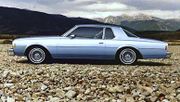
The changes in the automobile marketplace resulted in Chevrolet redesigning the Impala once again in 1977 to meet changing demands. The new downsized Impalas were shorter in length, taller and narrower than before. The new Impala's frame was a shortened version of the one introduced in 1971 and would be utilized until 1996 when the B-body production line was shut down. Even with its trimmer exterior dimensions, the new Impala featured increased headroom, legroom and trunk space.[13] Production of the downsized model increased substantially over 1976, and the Impala regained the number one US sales position. The redesigned 1977 Impala/Caprice was named Motor Trend′s car of the year. Pillarless hardtops were discontinued, the result of rumors of federal rollover standards looming in the near future. The 1977–1979 coupes sported a double bent tempered rear window similar to the 1987 Monte Carlo Aerocoupe.
Engine availability was reduced in 1977; the inline-6 was reintroduced with 110 horsepower (82 kW). Options included 267-cubic-inch (4.4 L) and 305-cubic-inch (5.0 L) V8 engines. The 350-cubic-inch (5.7 L) V8 engine was optional in some years. Oldsmobile's 350-cubic-inch (5.7 L) V8 diesel engine also was available.
| 1976–1977 Comparison[14][15] | 1976 Impala | 1977 Impala |
|---|---|---|
| Wheelbase | 121.5 in (3,086 mm) | 116.0 in (2,946 mm) |
| Overall Length | 222.9 in (5,662 mm) | 212.1 in (5,387 mm) |
| Width | 79.5 in (2,019 mm) | 75.5 in (1,918 mm) |
| Height | 53.7 in (1,364 mm) | 55.3 in (1,405 mm) |
| Front Headroom | 38.9 in (988 mm) | 39.0 in (991 mm) |
| Front Legroom | 42.5 in (1,080 mm) | 42.2 in (1,072 mm) |
| Front Hip Room | 59.3 in (1,506 mm) | 55.0 in (1,397 mm) |
| Front Shoulder Room | 63.8 in (1,621 mm) | 61.1 in (1,552 mm) |
| Rear Headroom | 38.0 in (965 mm) | 38.2 in (970 mm) |
| Rear Legroom–ins. | 38.8 in (986 mm) | 39.5 in (1,003 mm) |
| Rear Hip Room | 59.7 in (1,516 mm) | 55.7 in (1,415 mm) |
| Rear Shoulder Room | 63.8 in (1,621 mm) | 61.1 in (1,552 mm) |
| Luggage Capacity | 18.9 cu ft (535 L) | 20.9 cu ft (592 L) |
In 1980, all new sheet-metal was used, although the body style remained similar. The Impala and the upscale Caprice sold well into the early 1980s. The Impala was reduced to the base model full-size Chevrolet and was popular with fleet usage – including taxi and police pursuit vehicles but was discontinued in 1985, while the Caprice continued unchanged until 1990.
Seventh generation (1994–1996)
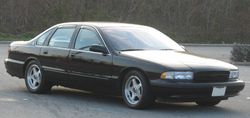 1995 Chevrolet Impala SS 4dr Sedan 1995 Chevrolet Impala SS 4dr Sedan |
|
| Production | February 1994 – December 1996 |
|---|---|
| Model year(s) | 1994–1996 |
| Assembly | Arlington, Texas |
| Body style(s) | 4-door sedan |
| Layout | FR layout |
| Platform | B-body |
| Engine(s) | 5.7 L (350 cu in) LT1 V8 |
| Transmission(s) | 4-speed automatic |
| Wheelbase | 115.9 in (2,944 mm) |
| Length | 214.1 in (5,438 mm) |
| Width | 77 in (1,956 mm) |
| Height | 54.7 in (1,389 mm) |
| Curb weight | 4,221 lb (1,915 kg) |
| Related |
|
In 1991, the GM B platform was extensively redesigned, though it retained the same shortened frame design of the 1977 redesign. The Impala SS badge was resurrected at the 1992 Detroit Auto Show as a concept car designed by GM designer Jon Moss. The concept car was two inches lower to the ground than the regular Caprice, and was powered by a 8.2-liter (500 cu in) engine. Eventually, the concept car's engine was replaced with a 5.7-liter (350 cu in) engine derived from the Corvette in order to show the public what would be offered if put into production (an off-road specification 510-cubic-inch (8.4 L) V8 was eventually put into the engine bay of the prototype years later).
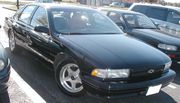
The 1994 Impala SS went into production on February 14, 1994 at GM's plant in Arlington, Texas,[1] and was almost identical cosmetically to the concept car, the only noticeable change being the chromed bowtie logo on the grill (vs a red logo on the concept). The car was, in essence, a high-performance version of the Caprice. From a mechanical standpoint, it used the Caprice 9C1 police package as its base and as such got most of the equipment formerly available only to law enforcement and government agencies. This included a sport-tuned suspension with reinforced shocks and springs, a high-capacity upgraded reverse flow cooling system, larger and more powerful four-wheel disc brakes, transmission cooler, dual exhaust, a higher-output electrical system, and other minor mechanical alterations. Not all of the police equipment was carried over however, as the Impala SS did not get the external oil-to-air engine oil cooler, nor were all the body mounts secured (the standard Caprice and Impala SS were assembled at the factory with the front 3 body mounts missing one of the rubber cushions, while the 9C1 was assembled with all rubber cushions in place), although both are popular aftermarket additions to the Impala SS by their owners.
The Impala SS was uniquely fitted with a standard 3.08 gear. The limited-slip rear differential was standard (as opposed to the option G80 on Caprices) and suspension that was an inch lower. A retuned LT1 5.7-liter (350 cu in) small-block V8 was standard on the Impala SS, making 260 horsepower (190 kW) and 330 pound-feet (450 N·m) of torque (retuned from the prototype's 300 horsepower (220 kW) rating). The primary difference between the LT1 in the Impala and the LT1 that was in the Corvette and Camaro was that the Impala engine was fitted with cast-iron cylinder heads instead of aluminum ones, and a camshaft that was designed more for low-end torque than high-end horsepower. Another difference was that the Impala LT1 had 2 bolt main bearing caps while the Corvette LT1 had 4 bolt main bearing caps. The transmission used in the car was the 4L60E, which was itself an upgraded and revised version of the previous 4L60. However, the transmission was not beefed up for the power of the LT1, and transmission failures after 100,000 miles (160,000 km) were commonplace. A standard transmission was never available in the 1994–96 Impala SS. However there is a growing trend of replacing the 4L60-E transmission, with the T-56 (6 speed manual) from the Camaro and Firebird using aftermarket kits. Alternatively, a popular enhancement was the addition of a shift-kit and/or a more aggressive torque converter. Several other cars in the B-body line also shared a similar powertrain: these were the Chevrolet Caprice, Buick Roadmaster, and the Cadillac Fleetwood which all shared the LT1 engine and 4L60E automatic transmission.
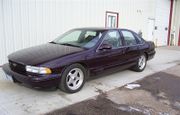
Cosmetically, the Impala SS received body-colored trim, which helped reduce the sometimes "bloated" look of the standard Caprice, a unique single-bar grille with no hood ornament and, a rear deck spoiler. It was fitted with 17-inch (430 mm) brushed aluminum wheels with 255/50ZR17 tires. Inside, the car came with a central console with cup holders (1994 and 1995 models) and a storage compartment, leather seats embroidered with the Impala SS logo, and a standard leather-wrapped steering wheel. For the 1994 model year, it was available only in black with a grey interior. Due to a shortage of the unique 5-spoke aluminum wheels (manufactured by ROH in Australia), only 6,303 cars were sold. However, the wheel shortage was remedied for the 1995 model year and 21,434 cars were sold.
In 1995, Dark Cherry Metallic and Dark Grey Green were added as exterior color options, and the body paneling on the rear quarter panel was altered to reflect the cosmetic effect formerly achieved by a window insert. Another change from 1994 was the placement of the side mirrors from pods attached to the door to a larger format attached to the 'A' pillar. 1996 was the last year of production with 41,941 units sold. The 1996 Impala SS production went late into the model year; the last one being produced on December 13, 1996. It saw minor interior alterations, with the digital speedometer being replaced by an analog one, along with a tachometer. The shifter was moved from the column to the center console, and the engine was given an OBD-II computer control system (the camshaft was reground to adjust for the new computer).
A special ceremony was held at the plant on December 13, 1996[2] for M.G. "Pinky" Randall, a Chevrolet collector from Houghton Lake, Mich., who bought the last Impala SS. When Randall drove the car with the dark cherry-metallic paint off the line, he was accompanied by County Judge Tom Vandergriff in the front passenger seat. In the back seat were Mayor Richard Greene, plant manager Herb Stone and Lonnie Morgan, president of United Auto Workers Local 276, which represents about 1,900 of the plant's 2,100 employees. "I didn't think this last car would get publicity like this," said Randall, 69. The Impala becomes the 46th vehicle in Randall's Chevrolet collection.
The entire B/D-body line, consisting of the Chevrolet Caprice, Impala SS, Buick Roadmaster and Cadillac Fleetwood, was discontinued by General Motors, as GM wanted more assembly lines to be able to produce more profitable SUVs. Another fact was that the Caprice was the only B-body with a market share since fleet sales to law enforcement outnumbered sales of all other B-bodies.
Eighth generation (2000–2005)
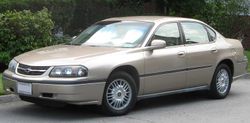 |
|
| Production | 1999–2005 |
|---|---|
| Model year(s) | 2000–2005 |
| Assembly | Oshawa, Ontario, Canada |
| Body style(s) | 4-door sedan |
| Layout | FF layout |
| Platform | W-body 2nd Gen |
| Engine(s) | |
| Transmission(s) |
|
| Wheelbase | 110.5 in (2,807 mm) |
| Length | 200.0 in (5,080 mm) |
| Width | 73 in (1,855 mm) |
| Height |
|
| Curb weight | 3,465 lb (1,572 kg) |
| Related | Chevrolet Monte Carlo |
The Impala name was resurrected for the 2000 model year as the "Hi-Mid" program to replace the Lumina. Based on the Lumina's W-body platform, it was built at Oshawa Car Assembly in Oshawa, Ontario, Canada. Unlike the earlier Impalas built on a B-body, this one was front-wheel drive and was available with a choice of two V6 engines, and slightly smaller. A new Impala SS with a supercharged V6 was brought out for the 2004 model year.

The Impala was available in two trim levels from 2000 to 2001. The base model came equipped with cloth bench seats, steel wheels, the 180 horsepower (130 kW) 3.4 liter (204 cu in) LA1 V6, and a 3-gauge instrument cluster.[16] The LS came factory-equipped with cloth bucket seats upgradeable to leather with center console and floor shift, color-keyed "Impala" door scripts and trunk badge, anti-lock brakes, traction control system, keyless remote entry, integrated foglamps, aluminum wheels upgradeable to alloy wheels, rear spoiler (optional on the base models), 4-gauge instrument cluster, and the larger 200 horsepower (150 kW) 3.8 liter (231 cu in) L36 V6.[17] Options available on all models included a sunroof, OnStar system, rear decklid spoiler, Driver Information Center with built-in HomeLink system, heated power front seats, and 16 inch 1990s SS-inspired wheels. All options found or available on the LS were available on the base model. All models came equipped with power windows, door locks and mirrors.
In 2002, Chevrolet introduced the LS Sport appearance package. Added to the LS model, it offered a 6-gauge cluster, front bumper extension, color-keyed tail light panels and a chrome exhaust pipe tip.
In 2003, the "Impala" badges that adorned the front doors were dropped on the base model , like on all GM W-body cars (except for the Chevrolet Monte Carlo and Pontiac Grand Prix).
The 2004 to 2005 Impala SS came equipped with the 3.8 liter (231 cu in) supercharged L67 V6 engine.[18] It was rated at 240 horsepower (180 kW) and had been previously used in the Pontiac Grand Prix GTP, Buick Regal GS, Buick Riviera, and H-body Pontiac Bonneville SSEI and Buick Park Avenue "Ultra". The lightweight front wheel drive sedan was actually quicker than the vaunted 1990s Impala SS, with 0–60-mile-per-hour (0–97 km/h) times pushing 6.5 seconds compared to the earlier models' 7.1. And the 04 LS model 0-60 in 10 seconds.

Also released with this version were the Police Package and Undercover Police Package, named 9C1 and 9C3, respectively. Available only to law enforcement agencies, fire departments, and EMS agencies, it has had more success than its predecessor, the Lumina 9C3. The 9C1 was basically a base model with a stronger suspension and the 3.8 liter (231 cu in) V6 engine. It was only available in a few basic colors. Another addition was the "SURV MODE" switch which replaced the fog light switch found on the LS. This enabled the driver to turn off all lights in the vehicle and "hide"; something not allowed with the civilian models as automatic headlights were standard. The 9C3 was comparably equipped to the 9C1, but the ability to add other convenience options and more paint and interior choices set the 9C3 apart.
Ninth generation (2006–present)
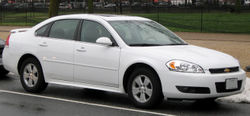 |
|
| Production | 2005–present |
|---|---|
| Model year(s) | 2006–present |
| Assembly | Oshawa, Ontario, Canada |
| Body style(s) | 4-door sedan |
| Layout | FF layout |
| Platform | W-body 3rd Gen |
| Engine(s) | |
| Transmission(s) |
|
| Wheelbase | 110.5 in (2,807 mm) |
| Length | 200.4 in (5,091 mm) |
| Width | 72.9 in (1,851 mm) |
| Height | 58.7 in (1,491 mm) |
| Curb weight | 3,764 lb (1,707 kg)[22] |
| Related |
|
The 2006 Impala was introduced at the 2005 Los Angeles Auto Show. Like the Buick LaCrosse, this model uses the updated GM W platform. The base engine is a 3.5 liter (214 cu in) V6 producing 211 horsepower (157 kW).[19] The new Impala features new taillights, different from the four-circle style of the previous generation.
The most notable news about the model, though, is the SS model's use of the Generation IV small-block V8 in a front-wheel drive Chevrolet for the first time, and the first V8 in a Chevrolet sedan since the 1996 Caprice: the new 5.3 liter (325 cu in) V8 (with Displacement on Demand, now called Active Fuel Management or AFM) produces 303 horsepower (226 kW).[21] With the use of the 5.3 liter LS4 V8, the Impala SS is capable of a 5.6 second 0–60-mile-per-hour (0–97 km/h) time and a quarter-mile time of 14.2 seconds traveling at 101 miles per hour (163 km/h).[23] The car is 200.4 inches (5,091 mm) long, 58.7 inches (1,491 mm) high, and 72.9 inches (1,851 mm) wide.
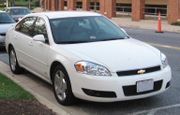
Available trim levels are LS, LT, LTZ and the aforementioned SS. LS became the base model. 6-passenger seating was only available as an option on the LS and LT models. Leather upholstery was standard on LTZ models and optional on LT models. The interior has been completely redesigned. The 2006 Impala featured a wood trim center console with chrome accents on all major control buttons. The dashboard featured a chrome Impala logo embedded in the wood grain trim that runs across the front of the vehicle and onto the doors. The new control knobs found throughout the vehicle's cockpit are similar to those found in the new Buick models as well as the Cadillac DTS, all of which feature a similar center console. Another interior revision is the location of the cupholders, which are now concealed beneath the mid-section of the vehicle's center console.
In 2007, the Impala received the FlexFuel 3.5-liter V-6 and Flex Fuel rear badge for the LS, LT, LTZ, 9C1 and 9C3 models. A new 3.9-liter V-6 with Active Fuel Management was available. The SS retained the same drivetrain and did not receive the FlexFuel feature due to the high performance nature of the powertrain. A tire-pressure-monitoring system, cruise control and a CD player were standard on all models, and a factory spoiler was an available option. The LT had 16-inch, 5-spoke alloy wheels. The generation-7 OnStar system with turn-by-turn navigation was included when the available directions & connections service was selected. The SS had standard leather-appointed seats and XM Satellite Radio, with XM being optional on LS, LT, and LTZ trims. There were four new exterior colors—Precisions Red, Imperial Blue Metallic, Bordeaux Red, and Red Jewel Tintcoat, as well as a Regency-outfitted "Impala RSS". The RSS included aggressive rims, front/rear bumper and rocker panel extensions, a BMW M-inspired spoiler and various interior upgrades.

The police sedans received the FlexFuel feature to compete against the Ford Crown Victoria Police Interceptor, which also received a similar feature allowing it to utilize E85. Also updated were the 9C1 & 9C3 trim levels for the Police Package models, which did not have the civilian SS's 303 horsepower (226 kW) V8 engine, but used the 3.9 liter (237 cu in) V6.[20] The reason being the Police Sedans utilized the SS radiator and cooling system as an upgrade from the standard 3.9 liter engine (used in the Impala LTZ). GM did not wish to design a specific radiator and cooling system to equip a low-production V8 police vehicle. Also, the heavy-duty steel wheels were not redesigned, and as such, the Police Sedan used the original center caps or the older style wheel covers. The 9C1 and 9C3 were equipped with an external trunk lock tumbler. Neither feature was available for the civilian version of the car. The 9C1 and 9C3 police models had aluminized interior trim instead of the standard wood grain.
To commemorate the Impala's 50th year, a 50th Anniversary Edition was introduced in Spring 2008. Based on the LT, it added: FE3 Sport Suspension (replacing the FE1 Touring Suspension), four-wheel ABS, eighteen-inch SS-style alloy wheels (replacing the 16-inch wheels), rear SS style spoiler , "50th Anniversary" Impala badges on the C-pillars, two-tone, leather-trimmed seats with "50th" logos embroidered on the front headrests, eight-way power-adjustable driver seat, leather-wrapped steering wheel with accent-color threading including audio controls, ebony carpet, ebony floor mats with accent threading, "50th" Anniversary emblems on the sill plates and a choice of two premium exterior colors: Black Granite Metallic and Red Jewel Tintcoat[24]
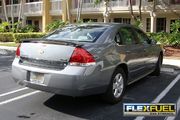
For the 2009 model year, the Impala received three new exterior colors: Victory Red, Silver Ice Metallic, and Aqua Blue Metallic. The brushed aluminum dash applique was no longer available, and 9C1 and 9C3 police models switched to the metallic silver trim from the SS models. All models used the previous SS style spoiler (actually phased in for the late 2008 model year). Leather seating was no longer available in combination with the 40/20/40 split bench front seat. The Active Fuel Management feature remained on the 5.3L V8 for the SS model, but was no longer available on 3.9L V6 for the LT and LTZ models. A sun and wheel package was available on 1LT models included power sunroof, overhead console with Homelink and 17" aluminum wheels. Thorax side-impact air bags were standard.
For the 2010 model year, the Impala is the only GM W-body car in production. The eight-cylinder SS model has been discontinued. LT models now include fog lights. The 3.9L V6 is no longer available for the LT model. Three new exterior colors are available: Summit White, Cyber Gray Metallic, and Aqua Blue Metallic. Four exterior colors have been deleted. The (PDG) convenience package, AM/FM stereo with 6-disc in-dash CD changer, and trunk cargo net are no longer available. The Impala emblems on rear sail panels as well as the rear decklid badge on LS models have been deleted. Early '10 models had the lower front-side GM badges but were also later deleted.[25][26]
Safety
In the Insurance Institute for Highway Safety's crash tests, the Impala is given an overall "Acceptable" score for front impact collisions.[27] and a "Good" score for side impacts. Side curtain airbags are standard for front and rear rows; side torso airbags previously unavailable became standard on all trim levels beginning with the 2009 model year.[28] GM made some minor structural enhancements to the Impala, beginning in December 2009; models produced after that received a "Good" in the IIHS frontal offset crash test.[29]
In September 2009, a local news station's investigative team discovered that GM's fleet customers who purchased the 2006–2009 Impala were able to order them with the side-curtain airbags deleted for a savings of $175 per vehicle. Because these fleets typically sell off their cars after 2–3 years of use, many of the Impalas that were built without side-curtains have gone on to become privately owned cars; however, the current owners cannot easily determine that their cars were not equipped with a safety feature that would otherwise be standard.[30]
Awards
Motor Trend magazine awarded the full-size Chevrolet including the Impala as its 1977 Car of the Year.[31]
Automotive Fleet and Business Fleet magazines awarded the Impala the 2006 and 2007 Fleet Car of the Year.[32]
Canadian Automobile Association (CAA) selected the Impala for its 2006 Pyramid Award for Environmental Initiatives for the launch of its new ethanol-powered E-85 model.[33]
Future
After rumors that Impala would return to rear wheel drive, General Motors confirmed that the next generation model will continue to be front wheel drive, likely based on a variation of the global GM Epsilon II platform known as Super Epsilon II.[34] A hybrid version is also expected.[35]
NASCAR Sprint Cup
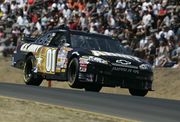
In 2007, the Impala began to replace the Monte Carlo on the NASCAR stock car racing circuit; more specifically, on all the scheduled racing events where NASCAR has mandated the use of a car with different (and some) new specifications, better known as the Car of Tomorrow, it was recently announced that in 2008 the Impala will be the only Chevrolet nameplate on the NASCAR Sprint Cup Series.
Notes
- ↑ 1.0 1.1 "1994 Impala SS". Motor Trend. June 1994. http://www.caminokid.com/ImpalaSSFAQs.htm. Retrieved 2010-06-26.
- ↑ 2.0 2.1 "Friday the 13th". Pgctv.Com. 1996-12-13. http://www.pgctv.com/videos/thelastss/. Retrieved 2010-07-19.
- ↑ 3.0 3.1 The editors of Consumer Guide
- ↑ "Top 20 selling vehicles in U.S. through December". Theautochannel.com. http://www.theautochannel.com/news/2009/01/05/346524.html. Retrieved 2009-05-11.
- ↑ 5.0 5.1 5.2 Flory, J. "Kelly", Jr. American Cars 1960–1972 (Jefferson, NC: McFarland & Coy, 2004)
- ↑ 6.0 6.1 The Editors of Consumer Guide
- ↑ Chevrolet engineering-1958 Chevrolets
- ↑ Flory, J. "Kelly", Jr. American Cars 1960–1972 Jefferson, NC: McFarland & Coy, 2004
- ↑ Flory, J. "Kelly", Jr. American Cars 1960–1972 (Jefferson, NC: McFarland & Coy, 2004), p.412.
- ↑ Gunnell, John, Editor (1987). The Standard Catalog of American Cars 1946–1975. Kraus Publications. ISBN 0-87341-096-3.
- ↑ Flory, J. "Kelly", Jr. American Cars 1960–1972 (Jefferson, NC: McFarland & Coy, 2004), p.865.
- ↑ "1980 CHEVROLET IMPALA (VE)". Dkarros.com. http://dkarros.com/es/index.php?option=com_content&view=article&id=731:1980-chevrolet-impala&catid=15:1980&Itemid=16. Retrieved 2010-07-19.
- ↑ 1978 Chevrolet Full Size brochure
- ↑ "1976_Chevrolet_Full_Size-10". http://www.oldcarbrochures.com/main.php?g2_itemId=25989. Retrieved 2010-01-04.
- ↑ "1977_Chevrolet_Police-03". http://www.oldcarbrochures.com/main.php?g2_itemId=26380. Retrieved 2010-01-04.
- ↑ 16.0 16.1 "GM Powertrain Car Engines 2005". Media.gm.com. http://media.gm.com/division/2005_prodinfo/powertrain/engines/05_car_engine_specs.html#la1. Retrieved 2009-05-11.
- ↑ 17.0 17.1 "GM Powertrain Car Engines 2005". Media.gm.com. http://media.gm.com/division/2005_prodinfo/powertrain/engines/05_car_engine_specs.html#l26. Retrieved 2009-05-11.
- ↑ 18.0 18.1 "GM Powertrain Car Engines 2005". Media.gm.com. http://media.gm.com/division/2005_prodinfo/powertrain/engines/05_car_engine_specs.html#l32. Retrieved 2009-05-11.
- ↑ 19.0 19.1 [1]
- ↑ 20.0 20.1 [2]
- ↑ 21.0 21.1 [3]
- ↑ 2006 Chevrolet Impala SS – Road Test / Family Four Doors / Car Shopping / Hot Lists / Reviews / Car and Driver – Car And Driver
- ↑ 2006 Chevrolet Impala SS – Road Test / Family Four Doors / Car Shopping / Hot Lists / Reviews / Car and Driver – Car And Driver
- ↑ 2008 Chevy Impala 50th Anniversary Edition coming to Detroit
- ↑ "Model Information – Online Ordering Guide". Eogld.ecomm.gm.com. http://eogld.ecomm.gm.com/NASApp/domestic/proddesc.jsp?year=2010&butID=1®ionID=1&divisionID=3&vehicleID=8781&type=0#. Retrieved 2009-06-20.
- ↑ GM to drop corporate logo from vehicles – Detroit News
- ↑ "IIHS-HLDI: Chevrolet Impala". Iihs.org. 2008-11-25. http://www.iihs.org/ratings/rating.aspx?id=640. Retrieved 2009-05-11.
- ↑ www.chevrolet.com
- ↑ http://www.iihs.org/ratings/rating.aspx?id=1372
- ↑ "Missing Airbags Put Chevy Impala Drivers at Risk | Target 12". WPRI.com. http://www.wpri.com/dpp/news/local_wpri_target_12_missing_airbags_chevy_impalas_20090917_nek. Retrieved 2010-03-03.
- ↑ Motor Trend: Car of the Year-February 1977
- ↑ "Automobile.com Fleet Segment Awards". http://car-reviews.automobile.com/news/new-chevy-impala-and-ford-f-150-win-fleet-segment-awards/1585/.
- ↑ "CAA Pyramid Award". http://www.cartest.ca/caa_presents_2006_pyramid_aw.htm.
- ↑ Approved: Impala Staying Front-Wheel Drive
- ↑ "REPORT: Lutz says next Chevy Impala to stay front-drive, gain hybrid variant" from Autoblog (November 16, 2009)
References
- Gunnell, John, Editor (1987). The Standard Catalog of American Cars 1946–1975. Kraus Publications. ISBN 0-87341-096-3.
- Biel, John (2005), "A Glass Half Full: The Story of the 1958 Chevrolet", Collectible Automobile 21 (6): 8–23, http://auto.consumerguide.com/product/collectible/index.cfm
External links
- Official site
- Appearances of the Impala in TV and film
- North American Impala Owners Association – Your source for late model Impala information
- History of the Chevrolet Impala 1958–2001
| Type | 1950s | 1960s | 1970s | |||||||||||||||||||||||||||
| 0 | 1 | 2 | 3 | 4 | 5 | 6 | 7 | 8 | 9 | 0 | 1 | 2 | 3 | 4 | 5 | 6 | 7 | 8 | 9 | 0 | 1 | 2 | 3 | 4 | 5 | 6 | 7 | 8 | 9 | |
| Subcompact | Vega | |||||||||||||||||||||||||||||
| Monza | ||||||||||||||||||||||||||||||
| Chevette | ||||||||||||||||||||||||||||||
| Compact | Corvair | Corvair | ||||||||||||||||||||||||||||
| Chevy II / Nova | Nova | Nova | Nova | |||||||||||||||||||||||||||
| Mid-size | Chevelle / Malibu | Chevelle / Malibu | Malibu | |||||||||||||||||||||||||||
| Monte Carlo | Monte Carlo | Monte Carlo | ||||||||||||||||||||||||||||
| Full-size | Fleetline | 150 | 150 | Delray | ||||||||||||||||||||||||||
| Styleline | 210 | 210 | Biscayne / Brookwood | |||||||||||||||||||||||||||
| Deluxe | Bel Air | Bel Air | Bel Air | Bel Air | Bel Air | |||||||||||||||||||||||||
| Beauville | Impala | Impala | Impala | Impala | Impala | |||||||||||||||||||||||||
| Nomad | Nomad | Caprice | Caprice | Caprice | ||||||||||||||||||||||||||
| Sports | Camaro | Camaro | ||||||||||||||||||||||||||||
| Corvette | Corvette | Corvette | ||||||||||||||||||||||||||||
| Type | 1980s | 1990s | 2000s | 2010s | ||||||||||||||||||||||||||||
| 0 | 1 | 2 | 3 | 4 | 5 | 6 | 7 | 8 | 9 | 0 | 1 | 2 | 3 | 4 | 5 | 6 | 7 | 8 | 9 | 0 | 1 | 2 | 3 | 4 | 5 | 6 | 7 | 8 | 9 | 0 | 1 | |
| Subcompact | Monza | Sprint | Metro | Aveo | ||||||||||||||||||||||||||||
| Chevette | ||||||||||||||||||||||||||||||||
| Spectrum | ||||||||||||||||||||||||||||||||
| Nova | ||||||||||||||||||||||||||||||||
| Compact | Citation | Prizm | Cobalt | Cruze | ||||||||||||||||||||||||||||
| HHR | ||||||||||||||||||||||||||||||||
| Cavalier | Cavalier | Cavalier | Volt | |||||||||||||||||||||||||||||
| Mid-size | Malibu | Corsica / Beretta | Malibu | Malibu | Malibu | |||||||||||||||||||||||||||
| Celebrity | Lumina | Lumina | ||||||||||||||||||||||||||||||
| Full-size | Impala | Impala SS | Impala | Impala | ||||||||||||||||||||||||||||
| Caprice | Caprice | Caprice | ||||||||||||||||||||||||||||||
| Personal | Monte Carlo | Monte Carlo | Monte Carlo | Monte Carlo | ||||||||||||||||||||||||||||
| Sports | Camaro | Camaro | Camaro | Camaro | ||||||||||||||||||||||||||||
| Corvette | Corvette | Corvette | Corvette | |||||||||||||||||||||||||||||